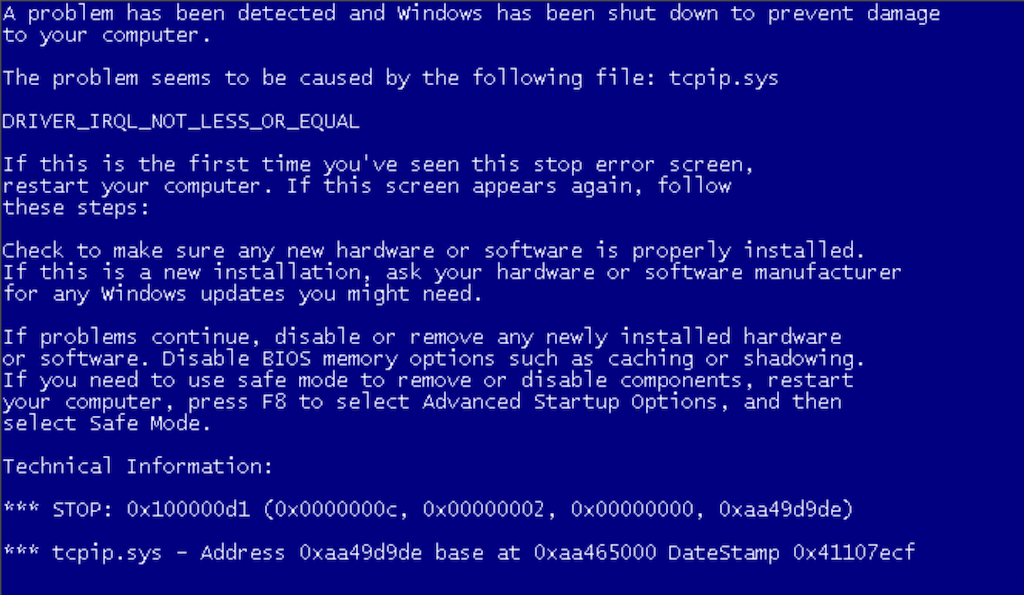The screen that nobody wants to see
The dreaded Blue Screen of Death (BSOD) has been around since Windows 95. It’s a dreaded error screen that pops up with little or no warning, letting you know that things have gone sideways on your computer.
Often, the problem goes away for good after a simple reboot. Still, intermittent or frequent BSODs can indicate anything from severe software bugs to computer hardware problems. BSODs are nothing to panic about, at least in most cases. You need to analyze the content of the BSOD error and troubleshoot potential solutions.
What Is a BSOD on Windows 11/10 Exactly?
You’ve probably discovered that Microsoft doesn’t officially call this error a Blue Screen Of Death. That’s a name user communities have given it over the years. The correct term for the error is a “stop error” or “exception error.” Both of these are types of fatal system errors, more commonly known as system crashes.
When a fatal error happens to an application running on the computer, it usually sends an error message and closes. But what if the bug or issue causing such a severe error happens to the operating system? That’s a BSOD, and the computer needs to be restarted.
If it weren’t for stop errors such as these, you’d risk serious malfunction or data loss. BSODs are, therefore, a way to protect your computer from damage.
Take a Photo of the BSOD Screen
Since your entire operating system stops when a BSOD happens, it’s a good idea to snap a quick picture of the screen with your smartphone. As you’ll see, an internet-connected smartphone is your best friend when troubleshooting BSODs since you will likely have no internet access on the affected computer.

To acknowledge this fact, Microsoft has also changed how blue screens look in Windows 11 and 10. You’ll see what we mean by that in a minute, but it’s best to first look at a Windows BSOD’s anatomy as a whole.
Common BSOD Errors in Windows 11/10
Many potential BSOD errors exist, but some are more common than others. Because of that, it’s worth having at least a passing familiarity with the most common stop codes you’ll see as a Windows user:
- PAGE_FAULT_IN_NON_PAGED_AREA: Windows can’t find critical data in the protected part of RAM. That could be due to faulty RAM, Windows file corruption, or a rogue application writing to memory locations it should not be.
- IRQL_NOT_LESS_OR_EQUAL: A BSOD typically caused by a malfunctioning driver. Typical solutions include reinstalling, updating, or rolling back drivers.
- NTFS_FILE_SYSTEM or FAT_FILE_SYSTEM: BSOD that stems from problems with the drive or the corruption of critical data. Fixes involve scanning and repairing the drive.
- OUT_OF_MEMORY: Stop error caused by failing RAM or problems with memory management.
- BAD_POOL_CALLER: A hardware driver accessed memory without the proper permissions, causing the system to crash.
- UNABLE_TO_LOAD_DEVICE_DRIVER: A hardware driver is corrupt—you must reinstall the driver or roll your system back to the previous driver.
- KMODE_EXCEPTION_NOT_HANDLED: Technical errors in an application forced a shutdown of Windows. Uninstall recent software or update current software to the latest version. If this error shows a .sys file as the culprit, you’ll want to run the System File Checker.
The BSODs above are a good example of what stop errors look like and the sorts of problems and solutions each one entails. In the end, there are really only four major causes:
- Bad hardware.
- Damaged Windows installations.
- Bad drivers.
- Rogue or buggy software applications.
The real trick is figuring out the source of the problem.
Rare Yet Specific BSODs in Windows 11/10
Common BSODs have plenty of fixes and advice available online. However, there are a handful that may prove tricky to fix. The good news is that we’ve already gone to the trouble of writing guides for the more egregious ones.
System memory errors are pretty common, mainly because there’s little tolerance for errors in RAM hardware. Windows itself has a no-nonsense approach to software messing with memory in ways it’s not supposed to.
An example is the Memory Management BSOD. Our guide on fixing the Memory Management BSOD in Windows should help you tackle a relatively rare version of this stop error.

Another difficult BSOD is the Unexpected Store Exception error. Despite its name, the actual cause is usually hardware failure. You can learn about it—and how to fix it—by referring to our unexpected store exception troubleshooting guide.
Then there’s the fatal System Service Exception stop code. It’s challenging to resolve because it has so many potential causes. Hop over to our System Service Exception error guide to track down the real culprit.
The last BSOD no one wants to see is Critical Process Died. This one is pretty non-specific, but if you check our Critical Process Died troubleshooting tutorial, you’ll figure out the underlying reason with a bit of luck.
BSOD Memory Dumps in Windows 11/10
Sometimes, you’ll need to call in expert help to figure out precisely what went wrong when a BSOD happens. Luckily, in most cases, Windows creates a dump of what’s in your memory when the stop error occurs. These are usually saved as “.DMP” files. By default, you’ll find them inside your Windows folder.
If you manage to boot back into Windows or access the system drive in some other way, it’s worth saving these dump files to something like a USB flash drive and then keeping them in case the problem happens again. Microsoft, hardware vendors, and software developers can use these dumps to see what happened when things went wrong.
Basic BSOD Fixes in Windows 11/10
It can sometimes feel that BSODs are a thing of the past since they happen so rarely these days. Nonetheless, if you’re staring at one, it’s worth considering the basic, general troubleshooting process to get your computer back up and running:

Take a Photo
As we mentioned above, take a photo of the BSOD with your phone in case you need to submit it or look up information about it. The screen may also contain additional information that you’d otherwise miss, such as references to specific drivers or memory locations.
Check Online for Fixes
Google is your friend, so perform a cursory search for the stop error code mentioned in the BSOD. You can also turn to the Microsoft Support Community forums, the Blue Screen of Death community on Reddit, or check our own troubleshooting guides.
Undo Recent Changes
If something has recently changed on your computer, such as an operating system or drive update, undo that change. The best way to do that is through System Restore. In severe instances, you might want to factory reset your Windows 11 or 10 installation.
Disconnect External Devices
External hardware devices can interfere with how your computer operates. So, unplug all unnecessary devices from your computer to see if that resolves the issue.
Analyze Memory Dumps
Remember when we talked about BSOD dumps? If you feel up for it, use Microsoft’s WinDbg or BlueScreenView by Nirsoft to analyze BSOD dumps yourself. Our complete guide analyzing BSOD dump files walks you through using both tools.

Update Hardware Devices
If you’re dealing with a BSOD related to a specific hardware device, such as your GPU, visit the hardware manufacturer’s website and download and install the latest drivers. You can also use a dedicated driver update tool to help you with that.
Check the Internals
If nothing seems wrong in terms of software and you’re running a desktop system, consider checking inside the CPU casing to ensure everything’s properly connected and seated. You might also want to remove and reinsert removable components like the RAM modules.
Perform a RAM Test
Failing RAM is a common issue behind hard-to-troubleshoot BSODs. Conducting a memory test with a tool like Memtest86+ should help you rule that out.
Reset the BIOS/UEFI
If you’re overclocking your computer’s CPU, RAM, or GPU or have firmware settings that could cause instability, reset the BIOS or UEFI to revert those changes.
You Might Have to Seek Professional Support
When all else fails, don’t be afraid to call in the help of a professional or turn to technical forums for help. It’s often better to spend a little money on tech support than spend hours and hours trying to figure out what’s causing a seemingly random BSOD.







